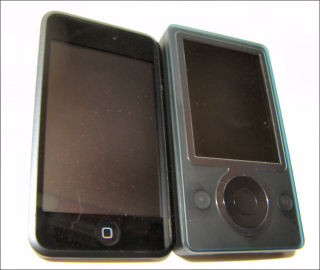The old Windows CE Handheld PCs had large (by today’s thumb keyboard standards) physical keyboards and a touch screen. They never caught on (even though I really enjoyed using them :-). The problem was that the touch screen were really just a substitute for a mouse and the need to pick up a stylus in between typing was annoying.
Following the lead of the Palm Pilot, Microsoft moved on to the Palm-size/Pocket PC and dropped the physical keyboard completely. Then RIMM’s Blackberry and Palm’s Treo showed that a physical keyboard was indeed a good thing but needed to be sized and designed correctly. Many current generation Windows Mobile Pocket PCs (Professional Edition) and Smartphones (Standard Edition) have physical thumb keyboards too. And, many of them are well designed (I particularly like the Dash’s and TyTyn’s).
Recently, Apple went retro and introduced the iPhone and iPod touch with touch screens that don’t need (or work) with a stylus and dropped the physical keyboard in favor of a graphical tactile-less one. On one hand, the finger gestures for viewing photos and navigating web pages works much better than stylus based Pocket PCs or keyboard based Smartphones. On the other hand, I guess I’m just one of those fumble-fingered people who prefers tactile feedback when typing (even thumb typing). I do think it is great that I don’t have to reach for a stylus to use the iPod touch. But, I really wish I had some kind of option (Bluetooth keyboard for example) for the iPod touch.
I was originally going to comment on the relative granularity differences between finger touch screens and stylus touch screens. But, I need to think that through a bit more. It just occurred to me that one of the original applications categories for the Pocket PC were little mini-PhotoShop type drawing apps. Yet, those never did become very popular. And, we don’t see that category heavily pushed or sold these days. Part of the issue may be the relatively small processing power on mobile devices (compared to desktops). But, I wonder if the digitization errors inherent in any touch screen might have something to do with this too. More later…

